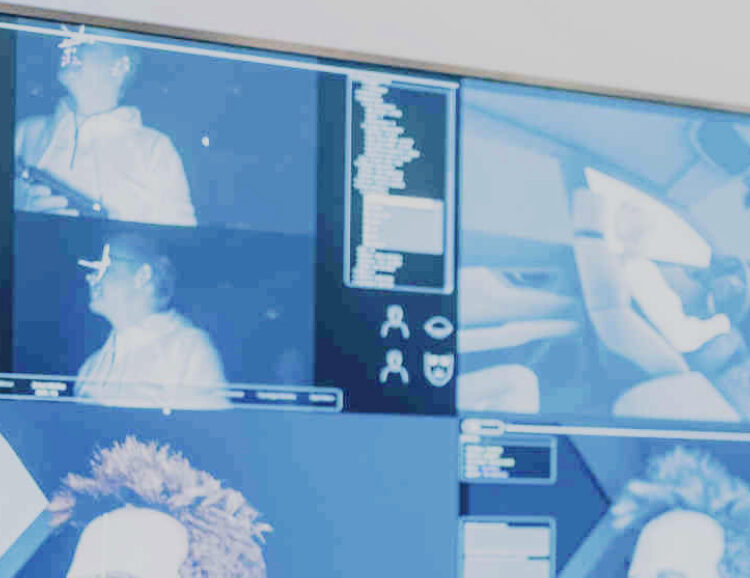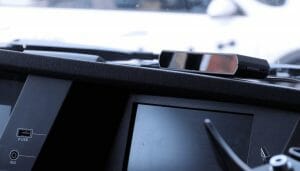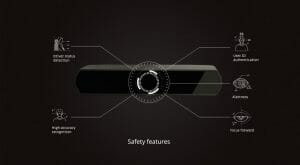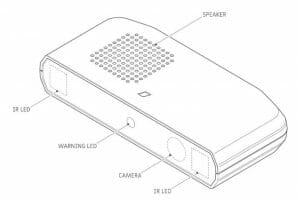/ Next post



In many ways, AIS is a unique Driver Monitoring System (DMS). By packaging our industry leading DMS software in our own purpose-built hardware, Smart Eye is able to offer a level of combined accuracy and flexibility that can’t be found in any other fleet driver monitoring systems on the market.
From perfecting our AI-based algorithms to developing the ideal camera, AIS is the result of many years of hard work. For fleets and small-volume vehicle manufacturers, it’s an essential safety technology based on machine learning, computer vision, massive amounts of data and over two decades of automotive experience.
But what does this really mean? Why is experience so crucial to enhance algorithms and ensure accuracy? How can hardware be used to bring out the best in a software? And what are the specific features that give AIS its unique flexibility?
Find out in this deep dive into the technology behind Smart Eye’s AIS driver monitoring system.
Smart Eye’s AIS is a fleet driver monitoring system designed to improve overall road safety by reducing road accidents and helping drivers perform at the best of their ability.
A complete hardware and software system, AIS consists of a standalone camera unit and an Electronic Control Unit (ECU) module. Thanks to its versatility and user friendliness, it’s an ideal system for aftermarket installation in the cabin of existing trucks, buses, and cars, and can also smoothly be deployed in new vehicles being produced in smaller volumes. Using wireless connectivity via Bluetooth and 4G/5G, it’s easily connected to fleet management systems, such as Geotab, for deeper insights and more efficient coordination.
Using a camera and Smart Eye’s AI-powered software, the system analyzes a driver’s face to identify even the most subtle changes in the driver’s head movements, eye gaze, and facial expressions, such as yawning and eyelid movement. This allows the software to detect early signs of drowsiness or distraction, alert the driver and let them refocus their attention before an accident even has a chance to occur.

AIS is built on the same software as Smart Eye’s world-leading driver monitoring system solution. This means the system is based on Smart Eye’s core algorithms for eye, head, and face tracking, that have been developed and continuously enhanced over the course of more than two decades.
These algorithms continue to be augmented all the time, which guarantees that AIS users are always given access to the best DMS software available through over-the-air updates. To learn more about how our algorithms are developed using machine learning and deep learning techniques, make sure to check out our eBook: From Eye Movement to Neural Network – An In-Depth Look at our Technology.
This technology is the basis for all our driver monitoring systems — including those already sourced for 229 vehicle models by 20 manufacturers such as BMW, Geely, and Polestar, and implemented in over 1,000,000 vehicles worldwide. After years of thorough testing by some of the automotive industry’s most demanding customers, our core tracking software can be relied on for precision and performance in any vehicle.
To qualify for implementation in automotive safety systems, we have also developed our software according to rigorous automotive safety standards, such as Automotive SPICE and Automotive Safety Integrity Level (ASIL). Out of the suppliers that offer complete hardware and software driver monitoring systems, there are only a few others who can make the same claim.
![]()
So, how does the core tracking software in AIS work?
First, using infrared light that is completely invisible to the driver, the AIS camera creates a reflection in the eye’s cornea. This then allows the camera to capture images of the driver’s eyes, face, and head – even if they are wearing sunglasses or a face mask. This is all the information the system needs to make a precise assessment of the driver’s state and the camera never captures any images of the rest of the vehicle, including the cab or driver’s seat. To get a more accurate and robust tracking performance, our solutions track each eye separately. Intelligent algorithms then identify the iris and pupil of each eye and weigh the two monocular feeds into a combined gaze direction for both eyes.
The images of the driver’s eyes, face and head are then run through Smart Eye’s DMS software, which uses AI-based algorithms to analyze the driver’s head, eye and facial movements and draw conclusions about their attention levels. Built on more than 20 years of automotive experience, the quality of Smart Eye’s algorithms ensures a very high level of accuracy. This lets the system recognize even subtle signs of drowsiness or distraction but also prevents it from issuing false warnings – something that can otherwise be a huge problem with less accurate systems. In fact, a system that keeps giving the driver false warnings can actually cause them to become more distracted, eventually disabling the system altogether. Needless to say, this completely defeats the purpose of a driver monitoring system.
The images captured by the AIS camera are processed on a SoC (System on Chip) on the ECU in real time – with no video data stored on device or in the cloud. This means that AIS offers data privacy, lowering barriers to adoption, and that it can be trusted to work in all situations, even without internet connectivity. It can also easily be upgraded and integrated with other systems by connecting to a vehicle CAN bus.

After many years, Smart Eye’s software has been thoroughly fine-tuned according to the high quality demands and diverse needs of our automotive customers. But for successful integration in vehicles, just perfecting a system’s software isn’t enough. A state-of-the-art driver monitoring system also needs to be supported by reliable hardware that allows you to take advantage of the full potential of the software.
At the end of the day, no one knows our software better than us. That’s why we’ve chosen to develop our hardware in-house to work perfectly with our AI algorithms. And with a shorter supply chain, we are able to offer this advanced technology at a very cost-effective price. Designed in Sweden, AIS embodies a long tradition of innovation and commitment to automotive safety – evident in everything from the stellar quality to the minimalist design of the system.
With two camera models – AIS 6 and AIS 12 – the system’s hardware can be adapted based on the type of vehicle it is installed in.
– AIS 6, a compact 1-megapixel model, proves ideal for original installations in passenger cars. The focal length of the AIS 6 camera is optimized for a 70 cm distance between the camera and the driver, which is the typical distance when the system is placed in a passenger car.
– AIS 12, a robust 2-megapixel camera, comes in two versions: one is meant for aftermarket installation in passenger cars, and the other is designed for heavier commercial vehicles. Both versions can be equipped with a radio card to enable remote communication with the system and data management in a cloud-based backend solution. The focal length of the AIS 12 camera is optimized for a 100 cm distance between the camera and the driver – the typical distance when the system is placed in a truck or bus. For best results, the camera should be mounted 40-120 cm from the eyes of the driver.
As technically advanced as AIS is, the full capacity of the system would go to waste if it wasn’t also easy to install and use, whether implemented in commercial vehicle fleets or in a new car model. To make this cutting-edge technology accessible to everyone, AIS is designed to be a true plug-and-play system.
Thanks to its intelligent dynamic self-calibration method, AIS can be up and running in just a few minutes. Once the system is installed in your vehicle it automatically calibrates the camera, requiring no effort from the user. As soon as the vehicle starts moving, the system analyzes the driver’s eye movements and determines the main focus area of their gaze during the first few minutes of driving. This area is then identified as the road ahead. Once the relationship between the driver’s gaze and the road ahead has been determined, the system can identify when the driver is visually distracted or getting drowsy. This fast and automatic self-calibration allows the system to be installed in different vehicle types, adjust to different drivers and positions, and still be ready to use almost immediately.

To make the user experience even smoother for drivers and fleet managers alike, Smart Eye has also developed an app specifically for AIS. Connecting to the system via Bluetooth, the AIS app supports installation, giving you instant feedback on the placement of the camera in your vehicle, as well as firmware updates. It also helps you customize system settings such as language, warning sensitivity levels, volume, and warning activation speed for detecting distraction, drowsiness, microsleep and driver presence. The Smart Eye AIS app supports iOS and Android and can be downloaded from the Apple App Store or Google Play store through an invitation link.
The true value of AIS lies in the sum of its different parts. The combination of Smart Eye’s advanced, proven DMS software and the carefully tailored hardware blends cutting-edge technology with the adaptability of a much simpler system.
We believe that innovation is most relevant when you find a way to make it easy to integrate in real-life situations. With AIS, we aim to demonstrate how AI can be more than a popular buzzword when combined with deep technical expertise and a practical approach. On our mission to bridge the gap between humans and machines, AIS leverages the cutting edge of technological innovation to genuinely enhance the safety and everyday experience of drivers everywhere.
Learn more about AIS or contact us today to request a demo of the system.
– Blog: 7 Factors that Distinguish Smart Eye’s AIS from Other Driver Monitoring Systems (DMS)
– Blog: 5 Ways Any Vehicle Benefits from a Driver Monitoring System (DMS)
– Blog Series: How the EU is Making Driver Monitoring Systems (DMS) Mandatory on European Roads
– eBook: Fit to Drive? 5 Key Insights into the State of Intoxicated Driving Research
– Blog: How Driver Monitoring Systems (DMS) Are Essential to Managing Fleets’ Financial Risks

